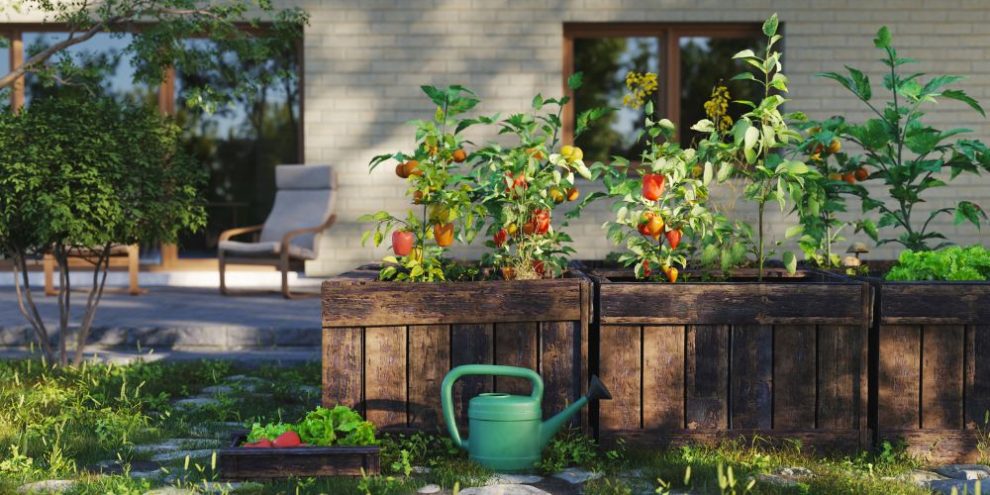
This Barrie 360 content is brought to you by United Lumber Home Hardware
Gardening has always been a popular activity for people of all ages, but with the rise of raised garden beds, it has become even more accessible and enjoyable. Raised garden beds have become a go-to for gardening enthusiasts and beginners alike, as they offer a variety of benefits over traditional gardens.
Whether you’re an experienced gardener or just starting out, this article will provide you with the information you need to get started with raised garden beds so you can reap the rewards of this popular gardening trend.
What Is A Raised Garden Bed?
A raised garden is a type of garden bed that is elevated above ground level. While this includes gardens where soil is simply piled high on the ground, most people enclose their raised gardens using a garden box or planter box. Some people even lift their gardens completely off the ground by adding legs to their boxes, which we’ll talk about in more detail later on.
Raised gardens are becoming increasingly popular due to their versatility and convenience but that’s not the only reason gardeners love them.
Why People Love Raised Garden Beds
Ergonomics is one of the main benefits of raised garden beds. Because you don’t have to bend as far to tend to your garden, they help reduce stress on your back, knees, and other joints. They also make gardening more accessible for people who use wheelchairs and walkers.
But raised garden beds can also improve growing conditions for your plants ...
1. Better Soil Quality
One of the biggest advantages of raised garden beds is the ability to control and improve soil quality. By using a raised bed, you can add your own soil mix and tailor it to the specific needs of your plants. This is especially beneficial if your native soil is lacking in nutrients, made up of clay, silt or sand, or has poor drainage. Using a garden bed on legs is also an effective way to avoid potentially contaminated soil.
Raised garden beds also reduce the risk of soil compaction from human and animal foot traffic. This makes tilling virtually unnecessary and can be a huge time saver if your native soil has large amounts of clay or rocks.
2. Improved Drainage
Raised garden beds give you more control over water conditions in your garden. If you live in an area where plants are prone to root rot due to moisture retention in the soil, raised gardens can help drain excess water away from your garden. Conversely, raised beds also improve water retention in areas with very sandy soil that can cause plants to dry out.
3. Better Animal Control
Raised garden beds don’t guarantee pest-free gardening but they can help remediate many weed and animal issues.
Firstly, the tall sides of your garden bed can slow down and even deter common pests like slugs and snails. (Not to mention, it makes it much harder for dogs to urinate on your garden).
If your raised garden sits on the ground, you can install galvanized hardware cloth on the bottom of your garden bed to prevent digging animals like groundhogs from stealing crops.
It is also easier to add deer fences, covers, and bird barriers for animals that aren’t deterred by the sides of your garden bed.
4. Easier To Prevent Weeds
Raised beds are less prone to weeds for a number of reasons.
Firstly, when constructing a raised bed, most people place a barrier such as landscape fabric or cardboard at the bottom of the box. This can effectively block the growth of weeds from the soil below.
Secondly, raised garden beds are typically filled with high-quality soil that is free of weed seeds, making it less likely for weeds to establish in the first place. If you decide to use your native soil, weeds may be harder to control.
In addition, because raised garden beds are constructed above ground level, they’re less likely to be invaded by weeds that spread through rhizomes or creeping roots, as these are more easily blocked by the raised bed walls.
Finally, because raised beds require minimum tilling, weed seeds that are in the soil or land on top of your garden are less likely to germinate.
5. Longer Growing Season
Raised garden beds are often filled with a high-quality soil mix, which can warm up faster than the surrounding ground in the spring. This allows gardeners to plant earlier in the season and extend the growing season by a few weeks.
Similarly, better drainage means that you can plant your gardens earlier in the season without risking damage from excess water.
6. More Versatile
While some garden box installations are more permanent, others can be designed for more temporary applications. As a result, you can move them around if you’re looking to change up your yard or relocate for improved growing conditions. And you can do it with minimal disruption to the plants themselves. This feature is especially beneficial for renters.
Similarly, unlike in-ground gardens, you can design garden boxes to go on decks, rocks, patio stones, etc. This is great for gardeners with limited lawn and soil areas.
The Pitfalls Of Raised Garden Beds
While raised garden beds come with several benefits, they aren’t free of disadvantages …
The main downfall of raised garden beds is the upfront costs. Before you even start thinking about what you want to plant, you have to invest in a garden bed kit (or lumber, materials, and tools if you want to DIY it). And you need some basic handy skills.
You’ll also need to budget for future repair and replacement. Though, the frequency and cost of this will depend on the materials that you use, which we will talk about in just a bit.
While many feel that raised beds add more visual interest and depth to their garden, you’re also fairly limited when it comes to design. While in-ground gardens can use more organic shapes, raised beds tend to be more linear and geometric.
Finally, raised beds can dry out quicker than in-ground gardens. This means you may need to water them more often.
How To Build A Raised Garden Bed
If you’re looking for something simple and straightforward, your best bet is to invest in a raised garden bed kit. If you’d like to get creative and want to DIY your own garden bed, there are tons of options available to you with many plans and ideas available for free online.
But before you get to your raised garden bed DIY, there are some important decisions you have to make …
RELATED: 7 tips for maintaining an outstanding year-round garden in Barrie ...
What Material Is Best For A Raised Garden Bed?
There are several materials you can use for raised garden beds, each with its own benefits and drawbacks. Here are some of the most common materials:
WOOD/LUMBER
Wood is a popular material for raised garden beds due to its natural appearance and affordability. Ideally, you want to use woods that are naturally resistant to rot and insects. This includes cedar, redwood, locust, and oak. Pine and fir are also commonly used, but they decay more quickly.
Advantages: Wood is affordable, easy to work with, and has a natural appearance that blends well with outdoor surroundings. It also provides good insulation for the soil, keeping it warm in the winter and cool in the summer.
Disadvantages: Wood may rot over time, especially if you don't maintain it properly. It can also be susceptible to insect damage, which can compromise the structure of the garden bed.
Can You Stain Your Raised Garden Bed? It's possible to stain your garden bed but you want to be sure to do your research. Some stains have ingredients that are toxic to plants, animals, and people. Oils just as linseed, tung, and walnut are good options. Or you can look for a non-toxic paint or stain.
PRESSURE TREATED WOOD
Pressure-treated wood is a type of wood that has been treated with chemicals to protect it from rot and insects. It is often used for outdoor projects, like fences and decks, but is not recommended for raised garden beds.
Advantages: Pressure-treated wood is affordable, easy to work with, and has good resistance to rot and insects. It’s also readily available at most home improvement stores.
Disadvantages: Pressure-treated wood contains chemicals that can leach into the soil and potentially harm plants and animals. While newer pressure-treated wood uses chemicals that are considered safer, it’s still important to exercise caution when using it in a garden setting.
PLYWOOD
Plywood is a type of engineered wood that’s made by gluing thin layers of wood veneer together. If you do plan on using plywood, look for softwood or hardwood types. Fiberboard (MDF) and particle board are not suitable.
Advantages: Plywood is affordable, easy to work with, and provides good insulation for the soil.
Disadvantages: Plywood is not as durable as other materials, and it can be prone to rotting and warping over time. It’s also not as aesthetically pleasing as some other materials and may need to be covered or painted to improve its appearance. Like pressure treated, there’s also a risk of plywood leaching chemicals into the soil, so it should never be used for plants you plan on eating.
UPCYCLING - PALLETS AND RAILROAD TIES
People often repurpose pallets and railroad ties for DIY projects. While they can be affordable and easy to work with, there are some important considerations to keep in mind.
Advantages: Pallets are often available for free or at a low cost, making them a popular choice for DIY gardeners on a budget. They are also easy to work with and can be disassembled and reassembled to create custom sizes and shapes.
Railroad ties are durable, long-lasting, and provide a rustic look that can be attractive in some settings. While you can repurpose old railroad ties, it’s not recommended.
Disadvantages: Pallets can be made from a variety of materials, some of which may not be safe for gardening. For example, pallets that have been used to transport chemicals or hazardous materials may be contaminated with harmful substances that can leach into the soil. Pallets can also be very difficult to take apart if you are wanting to deconstruct them first.
Railroad ties are treated with creosote, a toxic substance that can leach into the soil and potentially harm plants and animals. The use of creosote-treated wood in residential settings has been banned or restricted in some areas due to its potential health risks.
METAL
Metal is a long-lasting material that is resistant to rot and insects. It is often used for raised garden beds because of its longevity and modern, sleek appearance.
Advantages: Metal is strong, durable, and requires little maintenance. It’s also resistant to pests and rot.
Disadvantages: Metal can rust over time, which can compromise its structural integrity. It can also absorb heat, which can lead to overheating of the soil in the summer.
CONCRETE
Concrete is a popular material for raised garden beds because of its durability and longevity. Due to its weight, it’s often used for permanent garden beds that will not be moved.
Advantages: Concrete is durable, long-lasting, and provides excellent insulation for the soil. It’s also resistant to rot, insects, and fire.
Disadvantages: Concrete can be expensive and difficult to work with. It’s also heavy and difficult to move once it has been installed.
STONE
Stone is a natural and beautiful material that is often used for raised garden beds that are built into a slope or hillside.
Advantages: Stone blends well with the natural environment and provides excellent drainage for the soil. Like concrete, it’s resistant to rot, insects, and fire.
Disadvantages: Stone can be expensive unless you already have rocks on your property or a cheap source. It's also heavy, difficult to work with, and hard to move once installed.
CINDER BLOCKS
Cinder blocks are another popular choice among DIY gardeners for raised garden beds.
Advantages: Cinder blocks are affordable, easy to work with, and provide good insulation for the soil. They’re also durable and long-lasting, making them a great option for permanent garden beds. Additionally, you can fill the holes in the blocks with soil and use them as additional planting space.
Disadvantages: Cinder blocks can absorb heat, which can cause the soil to overheat in the summer. They are also prone to cracking over time, especially if exposed to freezing and thawing cycles. When using cinder blocks for raised garden beds, it is important to make sure you properly reinforce and anchor them to prevent shifting or collapsing.
How Big Should A Raised Garden Bed Be?
You have a lot of freedom when DIYing raised garden beds, which means you can make them any size you like. That being said, there are some general guidelines you should follow for optimal comfort and growth.
HOW DEEP SHOULD A RAISED GARDEN BE?
The depth of a raised garden bed can vary depending on what you plan to grow in it. Deeper beds also provide more room for the roots to grow and can help to promote better drainage and aeration of the soil. However, the deeper the bed, the more soil you will need to fill it, so consider the cost and effort of filling a deeper bed before deciding on the depth.
As a general rule, you want a depth of at least 12 inches for most plants. If there is a barrier at the bottom of your garden bed, whether it is fabric, wood, or hardware cloth, aim for at least 18”. The same applies if you are growing plants with deeper root systems, such as tomatoes, potatoes, or carrots.
HOW WIDE SHOULD A RAISED GARDEN BED BE?
The width of your garden bed has more to do with ergonomics. The wider your bed is, the farther you will have to stretch to tend to plants. There’s also a risk that you will need to step up and stand in the garden if it is too wide. This causes compaction, which affects growth, and defeats the purpose of using a raised garden in the first place.
Ideally, you want your garden box to be no more than 4’ wide. This will make it easier for you to reach the center of the bed without risking soil compaction. Many gardeners recommend making your box narrower and adding space by extending the length of your garden.
Other Design Considerations
When building a garden box, don’t just think about size. There are many other ways you can customize your garden box and make it work for you. Here are just a few:
COVER IT UP
You can add a cover to your raised garden bed to protect your plants from pests, harsh weather conditions, and excessive sunlight. You can use a simple hoop cover or DIY frame with a durable net or plastic cover to keep your plants safe.
GET IT OFF THE GROUND
Adding legs to your raised garden bed can be a great option for people who have limited space or mobility issues. This makes it easier to maintain the garden bed without having to bend over or kneel down. It’s also a good option for people who want their garden to be on a deck.
ADD WHEELS
If you are making a garden bed with legs for a deck or patio, consider adding wheels. This will make it easier to move it around if you need to rearrange your space or your garden isn’t in the optimal spot for success.
RELATED: 9 important things to remember when you build a deck ...
INSTALL A FENCE
Installing a fence around your raised garden bed is a great way to keep out animals, such as rabbits and deer, from eating your plants. For a simple fence, screw posts into your bed then surround it with chicken wire or deer netting. If you have multiple raised beds, you can fence off the whole area, instead of individual boxes.
ADD A TRELLIS
Trellises can help support climbing plants, such as tomatoes and beans, and can also add a decorative touch to your garden bed. You can create a trellis using bamboo poles or metal stakes and attach string or netting to provide support for your plants.
INSTALL IRRIGATION
Installing an irrigation system in your raised garden bed can save you time and water while ensuring your plants get the right amount of moisture. You can use drip irrigation systems or soaker hoses to water your plants.
These are just some ideas for customizing your raised garden bed to make it more functional, attractive, and efficient. Once you have figured out a design and have built your raised garden, it’s time to fill it.
What To Put In The Bottom Of A Raised Garden Bed?
There are a few different options for what to put in the bottom of a raised garden bed. Ultimately, the choice of what to put in the bottom of your raised garden bed will depend on your specific needs and preferences.
We have already covered some options, such as landscape fabric and hardware cloth, but let’s take a better look at these and others in more depth.
LANDSCAPE FABRIC
Many gardeners lay down landscape fabric to keep weeds and other unwanted plants from growing up into the bed. This can be especially useful if your bed is situated over grass or other vegetation.
HARDWARE CLOTH
Hardware cloth is steel mesh that is used for cages, fencing, and other purposes. It is similar to chicken wire but uses stronger gauge metal making it more durable and long-lasting. In garden boxes, it’s used to stop groundhogs and other burrowing animals from stealing crops.
It can also be attached around the outside of garden boxes to make it harder for other animals to eat and disturb your plants.
ROCKS OR GRAVEL
Some gardeners like to put a layer of rocks or gravel in the bottom of the bed to improve drainage and prevent soil from compacting.
NEWSPAPER OR CARDBOARD
Some gardeners like to put down a layer of newspaper or cardboard in the bottom of the bed to help suppress weeds and retain moisture.
WOOD
When building raised garden beds on legs, you will need to put a solid base to prevent your soil from falling out. Wood is the most common option but you can also use metal, composite, or plastic. The key is to ensure the base is durable while also allowing water to drain through holes or gaps between the wood. You should also add a layer of landscaping fabric to protect the wood and prevent soil from getting out through the drainage holes.
How To Fill A Raised Garden Bed
After you have chosen materials for and built your raised garden bed, it’s time to fill it up. Filling a raised garden bed involves adding layers of different materials to create nutrient-rich soil that will support healthy plant growth.
Here are the general steps for filling a raised garden bed:
- Add organic matter: Add a layer of compost or other organic matter, such as straw, wood chips, or leaves, to the bottom of the bed. This will help to improve soil quality and provide nutrients for your plants, which is especially helpful if your soil is low in nutrients.
Ideally, you want to have 10 to 20% compost and 80 to 90% topsoil. If you want more organics in your garden, you can. Just make sure it doesn’t exceed 50%.
- Add topsoil: Add a layer of topsoil on top of the organic matter. You can purchase topsoil from a garden center or use soil from your yard if it is good quality.
- Mix in amendments: Depending on your soil quality and the needs of your plants, you may want to add additional amendments such as lime, bone meal, or blood meal. Mix these into the top layer of soil.
- Add aeration: Many bagged topsoil mixes come with pumice, rice hulls, and other aerators. If you use your own soil or the mix does not include an aerator, you will have to add your own.
- Repeat layers (optional): Layer organic matter and topsoil until the bed is filled to the desired height. If you aren’t a fan of the lasagna method, you can simply pour in your compost and then your topsoil.
- Water thoroughly: After filling the bed, water it thoroughly to help settle the soil and ensure that all layers are moist.
- Wait before planting: Wait a few days before planting to give the soil time to settle. Be sure to read the directions on your amendments as they may require additional time to activate.
- Maintain soil: After you have planted your garden, you should only have to top off with compost once or twice a year. This will recharge the nutrients in your garden. Fertilizer is not necessary.
PRO TIP: Good quality soil will be crumbly and easy to work with. If it is too heavy or too sandy, you’ll want to source some different topsoil. When possible grab it from an area of your yard that has little to no grass or weeds.
What To Plant In Your Raised Garden Bed
The possibilities are nearly endless when it comes to choosing what to grow in your raised garden. There are, however, some plants that do especially well in this growing environment.
PRO TIP: No matter what you’re planting, always consider the height of your plants and the direction of the sun. Taller plants should be farther from the sun and shorter plants should be closer. Otherwise taller plants could cast shadows and stop smaller crops from growing properly.
Produce
With the rising price of produce, growing your own produce is a win-win situation. While raised gardens are good for several different crops, popular choices include:
- Vegetables - many of these benefit from the warm soil, improved drainage, and minimal compaction that raised beds are known for.
- Bush beans (pole beans are also good but they require additional support)
- Lettuce
- Kale
- Onions
- Beets
- Carrots
- Potatoes
- Fruits - thrive in raised beds where soil quality is easily controlled.
- Strawberries
- Tomatoes
- Melon
- Cucumber
- Peppers
- Herbs - due to shallow root systems, herbs can grow in raised beds that aren’t very deep
- Chives
- Basil
- Parsley (will need to replant each season)
- Rosemary
- Thyme
Flowering Plants
Raised garden beds are a great option for growing flowers, especially pollinators and cut flowers. While there’s a long list of flowers you can choose from, some great choices include:
- Cut Flowers - flowers that will regrow after you cut them for bouquets
- Marigolds
- Snapdragons
- Cosmos
- Zinnias
- Asters
- Pollinators - flowers that attract bees, butterflies, and more
- Black-eyed Susan
- Butterfly weed
- Canada Goldenrod
- Nasturtiums
- Purple coneflower
- Pest Control - flowers that deter mosquitos and other pests
- Lavender
- Garlic
- Citronella
- Lemon balm
- Peppermint
- Edible Flowers - flowers that you can eat
- Borage
- Bee blam
- Calendula
- Chives
- Marigold
Again, this is just a short list of plants you can choose from for your raised flower bed. Whatever you choose, it’s important to consider ideal growing conditions so you can choose complimentary flowers for the same bed and place your garden in the best location possible.
Where To Put Your Raised Garden Bed
When deciding where to put your raised garden bed, there are several factors to consider:
1. Sunlight
Giving your plants the ideal amount of sunlight is critical to proper growth. Some plants need partial sun while others need full sun or full shade. Be sure to choose a location that receives the proper amount of sunlight for your plants to do well.
2. Access to Water
Make sure your raised bed is within easy reach of a water source, such as a garden hose.
How Often Should You Water Your Raised Garden
The frequency of watering a raised garden will depend on several factors, such as the climate, the type of plants, and the soil quality. In general, you need to water raised gardens more frequently than ground-level gardens because the soil in raised beds tends to dry out more quickly.
As a general guideline, most plants in a raised garden will need about 1 to 1.5 inches of water per week, including rainwater. However, during hot and dry weather, you may need to water more frequently, possibly even daily. You should also monitor the soil moisture regularly by inserting your finger into the soil to determine if it feels dry or moist.
It's important to note that overwatering can be just as harmful to plants as underwatering. So, be sure to water deeply and thoroughly, but avoid saturating the soil or allowing water to pool on the surface.
3. Accessibility
Consider the location of the bed in relation to your home and any other outdoor spaces you use frequently. You may also want to consider ease of access for harvesting and maintenance.
4. Space
Ensure that your raised bed has enough space to accommodate the plants you want to grow, and allow for adequate air circulation around the plants.
5. Aesthetics
Last but not least, consider the aesthetics of the location, as you will likely be looking at it frequently. Choose a location that complements the overall look and feel of your outdoor space.
Overall, the best location for your raised garden bed will depend on your preference and the need of your plants. But keeping these factors in mind should help you make an informed decision.
Why Raised Garden Beds Are A Great Choice
Raised garden beds are a versatile and efficient way to grow plants, vegetables, and herbs in your backyard or any outdoor space. They offer numerous benefits, such as better soil drainage, less weed growth, and easier access to gardening activities.
Whether you’re a beginner or an experienced gardener, raised garden beds can provide a fun and rewarding experience for you and your family.
So why not give it a try and start growing?
RELATED: Ideas, tips & inspiration for your next home renovation or DIY project ...













